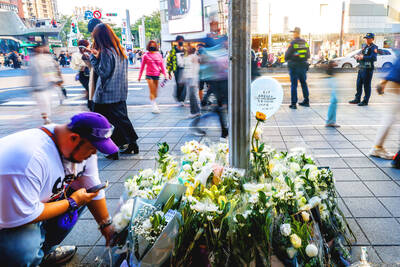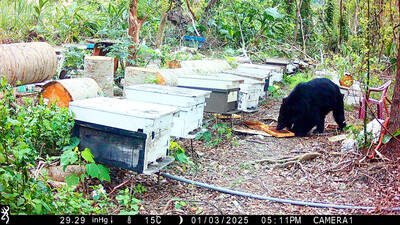Chinese Premier Li Keqiang (李克強) seemed eager to drive home a message to Taiwan’s next government on Thursday, when he met with former vice president Vincent Siew (蕭萬長), saying that both sides of the Taiwan Strait belong to “one China.”
Li and Siew met on the sidelines of the Boao Forum for Asia held in China’s, Hainan Province, with the Chinese premier saying that cross-strait relations would not change because a party that is known for its pro-independence stance would take over as the ruling party in Taiwan.
China plans to continue the peaceful development of bilateral ties based on the “political foundation of the 1992 consensus,” he said.
Li said the fruitful results from years of peaceful development of cross-strait ties were ample proof that maintaining the foundations of the “1992 consensus” would be a good way to create a bright future for both sides.
Not only can such a foundation maintain peace across the Strait, but it can also create benefits for people on both sides, he told Siew.
The premier said that China offers a good opportunity for Taiwan as a whole and Taiwanese investors in particular, as trade and investment ties would continue to boom based on the “1992 consensus.”
Siew agreed, saying that the foundation has been consolidated and it is the hope of everyone that the results achieved over the past eight years “will continue.”
The “1992 consensus” refers to a supposed understanding reached during cross-strait talks in 1992 that both Taiwan and China acknowledge that there is “one China,” with each side having its own interpretation of what that means.
In 2006, former Mainland Affairs Council chairman Su Chi (蘇起) admitted he made up the term “1992 consensus” in 2000, before the KMT handed power to the Democratic Progressive Party.
Speaking at a dinner party hosted by China’s Taiwan Affairs Office Minister Zhang Zhijun (張志軍) later on Thursday, Siew said that Beijing should deal with future challenges with intelligence, patience and pragmatism.
Siew proposed that Beijing face reality, which, he said, refers to the decisions made by Taiwanese.
Over the past eight years, the two sides of the Taiwan Strait have found an excellent common foundation for resolving their long-lasting differences, Siew said, adding that the relations between the two sides should be viewed from a long-term, rather than short-term, perspective.
Siew said he hoped that economic cooperation and exchanges between the two sides would continue to progress, no matter how bilateral ties might change.

SHIPS, TRAINS AND AUTOMOBILES: The ministry has announced changes to varied transportation industries taking effect soon, with a number of effects for passengers Beginning next month, the post office is canceling signature upon delivery and written inquiry services for international registered small packets in accordance with the new policy of the Universal Postal Union, the Ministry of Transportation and Communications said yesterday. The new policy does not apply to packets that are to be delivered to China, the ministry said. Senders of international registered small packets would receive a NT$10 rebate on postage if the packets are sent from Jan. 1 to March 31, it added. The ministry said that three other policies are also scheduled to take effect next month. International cruise ship operators

NUMBERS IMBALANCE: More than 4 million Taiwanese have visited China this year, while only about half a million Chinese have visited here Beijing has yet to respond to Taiwan’s requests for negotiation over matters related to the recovery of cross-strait tourism, the Tourism Administration said yesterday. Taiwan’s tourism authority issued the statement after Chinese-language daily the China Times reported yesterday that the government’s policy of banning group tours to China does not stop Taiwanese from visiting the country. As of October, more than 4.2 million had traveled to China this year, exceeding last year. Beijing estimated the number of Taiwanese tourists in China could reach 4.5 million this year. By contrast, only 500,000 Chinese tourists are expected in Taiwan, the report said. The report

HORROR STORIES: One victim recounted not realizing they had been stabbed and seeing people bleeding, while another recalled breaking down in tears after fleeing A man on Friday died after he tried to fight the knife-wielding suspect who went on a stabbing spree near two of Taipei’s busiest metro stations, Taipei Mayor Chiang Wan-an (蔣萬安) said. The 57-year-old man, identified by his family name, Yu (余), encountered the suspect at Exit M7 of Taipei Main Station and immediately tried to stop him, but was fatally wounded and later died, Chiang said, calling the incident “heartbreaking.” Yu’s family would receive at least NT$5 million (US$158,584) in compensation through the Taipei Rapid Transit Corp’s (TRTC) insurance coverage, he said after convening an emergency security response meeting yesterday morning. National

The Forestry and Nature Conservation Agency yesterday launched a gift box to market honey “certified by a Formosan black bear” in appreciation of a beekeeper’s amicable interaction with a honey-thieving bear. Beekeeper Chih Ming-chen (池明鎮) in January inspected his bee farm in Hualien County’s Jhuosi Township (卓溪) and found that more than 20 beehives had been destroyed and many hives were eaten, with bear droppings and paw prints near the destroyed hives, the agency said. Chih returned to the farm to move the remaining beehives away that evening when he encountered a Formosan black bear only 20m away, the agency said. The bear